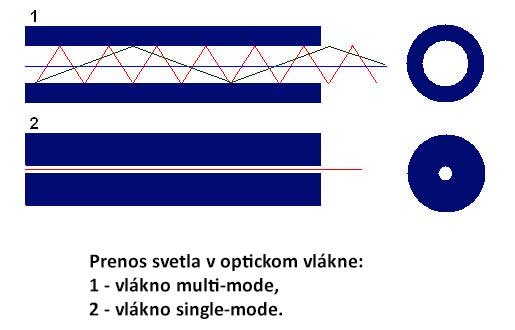You can find fiber optic networks today in many environments, such as data transport networks, LAN networks, underwater cabling, city access points, distribution networks, but also ISP networks. Connecting optical cables has therefore become a necessity.

Interesting information is that if we took all the fiber optics used today, the fibers were so long that they could wrap the Earth about 25,000 times, and every hour this fiber would grow several thousand kilometers.
How does it work in fiber optic cables?
Light transmission in optical cables is based on a full reflection phenomenon. The core is mostly made of alloyed glass, through which light passes along, while the casing is made of pure glass. The combination of materials determines their refractive index. To achieve complete internal reflection, the refractive index of the mantle (pure glass) must be less than the core index (alloyed glass). The protective layer over the shell is a primary protection made of heat-resistant, plastic materials and special gels that protect the fiber from mechanical damage.
How do we divide optical fibers?
We divide the fibers into multi-mode and single-mode.
We divide the fibers into multi-mode and single-mode.
The main difference between single-mode and multi-mode fiber is the way light is transmitted in the core. Multi-mode fiber transmits more modes (light rays of the same wavelength). Using multiple modes results in a variance that significantly reduces the range and rate of signal transmission. The signal is scattered over time because the propagation rate is not the same for all modes due to the different path lengths from the transmitter to the receiver. This difference is due to the different angle of reflection of the light rays in the core.

The Scattering Java phenomenon is eliminated in single-mode fiber that carries only one beam of light of a specific wavelength. In the case of single-mode fiber, the beam of light usually propagates parallel to the axis of the fiber. Data flow in single-mode fiber is limited by chromatic scattering. Chromatic scattering is a combination of the scattering of material and scattering lines. Phenomena lead to signal reduction. Material scattering is associated with a different refractive index for different wavelengths. In contrast, conduction dispersion is caused by the passage of the light beam through the fiber sheath. However, they do not significantly affect the signal quality of multi-mode cables. In addition, optical fibers are produced with so-called fiber optics. by dispersing the dispersion where these phenomena are eliminated.
The difference between multi-mode and single-mode fiber is also in its average.
Single-mode core – between 8 – 10 microns (typically 9 µm)
Multi-mode core – 62.5 or 50 micrometers.
Sheath diameter – 125 micrometers.
